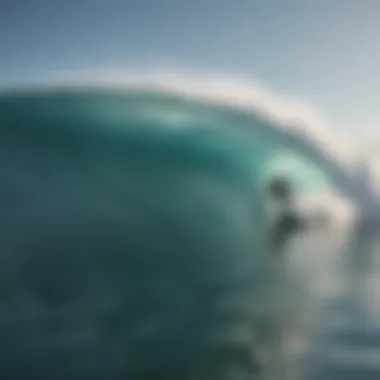Sounds for Surfing: Enhancing Relaxation Through Auditory Experiences


Intro
There’s something magical about the sound of waves crashing against the shore, isn't there? It wraps you up much like a warm blanket on a chilly evening. Every surfer, whether a seasoned pro or a newcomer with stars in their eyes, knows that the auditory landscape of the ocean is not just background noise; it is an essential part of the experience. This article digs deeper into how these sounds contribute to the sense of peace and calm that so many surfers cherish.
Imagine a morning at dawn when the surf is just right. As you sit on your board, waiting for the perfect moment to catch a wave, the ambient sounds begin to connect with your mind and body. The gentle lapping of water acts almost like a lullaby, luring you into a meditative state. It’s the kind of experience that can transform an ordinary day into something sublime.
In exploring the intricate relationship between sound and relaxation, we aim to highlight key elements that play a significant role in the surfing culture. Surfers don’t just ride waves; they embrace an entire soundscape that enhances their overall wellbeing. This exploration will cover a variety of auditory experiences, focusing on their psychological effects and how they can invite tranquility, mental clarity, and a deeper connection to the surf culture.
It's not just about catching waves; it's about inviting peace into your life. To get there, we’ll also share tips on how to incorporate these soothing sounds into your daily routine for optimal relaxation. So grab your board, and let's dive into the sonorous depths of the surfing experience, where every ripple and crash offers a note in the melody of your ride.
Surfing Techniques
Every surfer has their own relationship with the ocean, shaped by the techniques they utilize during their ride. These techniques can significantly impact not only your surfing prowess but also your mental state, given that mastering them often leads to an enhanced connection with your auditory surroundings.
Advanced Maneuvers for Experienced Surfers
For those who have gone beyond just catching waves, advanced maneuvers are where creativity and skill mesh. Chops, spins, and aerial tricks aren't just impressive displays; they also call for heightened awareness of the auditory cues around you. You start to hear the surf, recognizing the subtle differences in wave patterns and adjusting your movements accordingly.
Incorporating a sound-focused approach can elevate your surfing style:
- Wave Recognition: Understanding wave sounds helps you predict their actions. Every wave has a personality, and its sound can hint at its size and power.
- Timing: The rhythm of the ocean plays a vital role in timing your maneuvers. A well-timed move, synchronized with the sound of the wave, can give you a thrilling experience.
- Balance: As you engage in tricks, the sound of wind flowing around you can heighten your sense of balance and control, making it easier to maintain poise mid-air.
Beginner Tips for Catching Your First Wave
For newcomers, the ocean can be both a daunting place and a wonderful sanctuary. Here's where the auditory experience can provide solace. Listening that rhythmic crash is vital in cultivating patience and focus.
For beginners, here are a few tips that intertwine sound and technique:
- Listen to the Waves: Understanding the sound of waves helps you identify the right moment to paddle. There will often be a distinct shift in sound as a wave builds.
- Set Your Intent: Hear the call of the ocean and use that moment to ground yourself before you try to catch your first wave. Let the sound help you find the right mindset.
- Observe Nearby Surfers: Watching the more experienced surfers can provide important visual cues—complement that with what you hear. There's harmony in observing and listening that can accelerate learning.
In summary, the sounds of the ocean and your movements can blend beautifully, promoting a deeper sense of relaxation while allowing for skill development. Finding that connection between your actions and the ambient sounds can turn surfing from a simple pastime into a deeply enriching experience.
Prologue to Auditory Relaxation
The concept of auditory relaxation may seem abstract, yet it plays a significant role in our everyday lives, especially for those who have a passion for surfing. This section aims to illuminate the importance of sound as a tool for tranquility and clarity. The rhythmic sounds of the ocean, in particular, can create an atmosphere conducive to relaxation, which is crucial for surfers who seek both physical thrill and mental peace.
Auditory relaxation encompasses a diverse range of sounds that can positively influence our emotional and physical state. For surfers, listening to the gentle crash of waves or the distant calls of seagulls while sitting on their boards can induce a calming effect. These auditory experiences help in creating a soothing environment, promoting inner peace and enabling individuals to connect better with the rhythm of the sea.
Benefits of Auditory Relaxation
Engaging with relaxing sounds offers myriad benefits:
- Stress Reduction: Sounds from nature can help lower cortisol levels, leading to decreased stress and anxiety.
- Enhanced Focus: Surfing requires concentration and mental clarity. Sounds that promote relaxation can sharpen focus and improve overall performance.
- Mindfulness and Presence: The ocean's sounds can anchor your thoughts, pulling you into the present moment rather than letting worries drift through your mind.
- Physical Recovery: Calming sounds can lower heart rates and aid in faster recovery after surf sessions, making for a well-rounded approach to the sport.
This section will lay the groundwork for understanding how the environment we immerse ourselves in while surfing—specifically, its sounds—deeply influences our state of mind. It's not just about riding waves; it's also about riding a harmonious sound wave that enhances the surfing experience. As we explore deeper into soundscapes that support relaxation, consider how they fit into your surfing routine. For those not acquainted with surf culture, incorporating these elements can foster a greater appreciation of the sport beyond the physicality it demands.
In the subsequent sections, we will delve into the science underlying these auditory experiences, the natural soundscapes encountered while surfing, and practical ways to integrate relaxation techniques into the sport, reshaping how we perceive the symphony of sounds around us.
The Science of Sound and Relaxation
Understanding the science behind sound and its role in relaxation can be a valuable pursuit for surfers and enthusiasts aiming to enrich their oceanic experience. The auditory environment surrounding the surfer is not just about pleasant sounds; it involves a complex interplay of auditory waves, physiological responses, and psychological transformations. Sound, in this context, serves as both a backdrop and a healing mechanism, shaping the overall surfing experience.
Understanding Sound Waves
To delve into the realm of sound, one must first grasp the nature of sound waves. Sound waves travel through the air (or water) as pressure waves, creating vibrations that our ears can detect. When these waves reach the ear, they cause the eardrum to vibrate, and signals are sent to the brain to interpret these vibrations as sounds. Ocean waves crashing against the shore create a symphony of low-frequency sounds that can be exceptionally soothing. The rhythmic pattern created by waves following each other can evoke a sense of calm, reminiscent of soothing lullabies that cradle the listener into relaxation.
In essence, the sound waves of the ocean carry a quality that enhances the experience of surfing. Surfers often describe the sound of the waves as a comforting presence, as they serve to drown out disruptive thoughts. The sounds, combined with the visual beauty of the ocean, create an immersive sensory experience that encourages a deeper connection with the water.
Physiological Effects of Sounds
The body responds decidedly to various sounds, and these physiological responses can play a pivotal role in relaxation during surfing. For instance, research suggests that low-frequency sounds, such as the rumble of the ocean, can lead to reduced heart rate and lower blood pressure. This physiological reaction is critical for surfers, who've just paddled through turbulent waters or overcame an intimidating wave.


Sounds can also trigger the release of neurotransmitters like serotonin and dopamine. These chemicals are associated with mood improvement and a feeling of well-being. When surfers hear the lapping of waves or the distant calls of seagulls, the brain may respond with happiness-inducing chemical releases, enhancing the overall experience. The calming effects of sound can also alleviate physical tension, resulting in a profound sense of relaxation even amid the energetic environment of surfing.
Psychological Benefits of Auditory Stimulation
Auditory stimulation does not just affect physiological processes; it also carries significant psychological advantages. Sounds such as ocean waves or wind whistling past can serve as a natural form of mindfulness. When a surfer focuses on these sounds, they may become more anchored in the present moment, a characteristic of effective mindfulness practices. This present-moment awareness can help combat anxiety and stress.
A common phenomenon known as the "Mozart Effect" demonstrates how specific types of music can enhance brain function and emotional well-being. For surfers, the gentle background scores of ocean sounds can provide similar effects, leading to heightened focus, enhanced performance, and an overall enriching experience.
The connection between our auditory environment and mental states is profound. Embracing the sounds of nature while surfing can align the mind, body, and spirit, offering surfers not just sport, but the peace of mind that comes with it.
This exploration of auditory peace highlights that understanding the science of sound is not just an intellectual exercise; it can be a pathway to a more profound surfing experience. By appreciating how sound waves affect us physically and psychologically, surfers can leverage these elements to heighten their joy and peace while riding the waves.
Natural Soundscapes of the Ocean
When it comes to the surfing experience, the role of natural soundscapes, particularly those originating from the ocean, cannot be overstated. These sounds are not just auditory backdrops; they are integral to creating a sense of peace and serenity that many surfers seek. The rhythmic crashing of waves, the call of seagulls, and the whispers of marine life contribute to a profound connection to nature, enhancing both relaxation and focus.
The benefits of immersing oneself in these soundscapes are both psychological and physiological. For one, the ocean's sounds have a meditative quality, evoking feelings of calm and tranquility. They can help to drown out the noise of daily life and encourage the mind to drift into a more restful state. Engaging with these natural sounds can also promote mindfulness, an essential component of surfing. Surfers often find themselves more attuned to their surroundings, resulting in better performance and enjoyment on the water.
The Role of Ocean Waves
Ocean waves serve as the heartbeat of the sea, providing a constant, soothing rhythm that can help to center the mind. The low frequency of waves lapping against the shore creates a resonant sound that can linger in the background, creating an atmosphere conducive to relaxation.
Research indicates that listening to sounds of nature, such as waves, can lower cortisol levels, which are often associated with stress. Surfing, in turn, can amplify this effect. When surfers align their movements with the waves' natural rhythm, it creates a harmonic experience.
For many, this deep connection fosters a unique sense of belonging. By tuning into the waves, surfers embrace the transient moments, allowing themselves to feel at one with the ocean.
Seagulls and Marine Life Sounds
Beyond waves, the sounds of seagulls and other marine life enrich the ocean soundscape. Seagulls cawing overhead serve as a reminder of life thriving in the coastal environment, bringing an added layer of auditory complexity to the experience. Their cries, often echoing over the waves, create a sense of place that reminds surfers they aren’t just riding the waves but are part of a vibrant ecosystem.
Marine sounds, like the distant songs of whales or the playful clicks of dolphins, can offer even greater inspiration. Many surfers find that these sounds foster a deeper appreciation for marine conservation and ecological balance, reinforcing the importance of protecting these natural habitats.
"The ocean’s sounds create a soundtrack that resonates with the very core of a surfer’s being, establishing a connection that goes beyond the physical act of surfing".
In summary, the natural soundscapes of the ocean, typified by the rhythmic lull of waves and the lively calls of marine inhabitants, play a crucial role in shaping the surfing experience. Such sounds not only promote relaxation but also enhance mindfulness, allowing surfers to engage fully with both their sport and their environment.
Incorporating Sound into the Surfing Experience
In the fast-paced world that surfers often find themselves navigating, incorporating sound into the surfing experience can provide a much-needed oasis of calm. It’s not merely about riding the waves; the sounds that accompany those moments can deeply enhance the experience, creating an atmosphere that promotes relaxation and mindfulness. The intricate relationship between sound and surfing can shape both how surfers perceive the ocean and how they engage with their environment.
We must consider that sound can be harnessed as a tool for enhancing both performance and relaxation. This means not just choosing tunes that pump up your adrenaline but also recognizing how certain tracks can shield you from the chaos of life on land.
Creating a Relaxation Playlist
Choosing Tracks for Serenity
When curating a relaxation playlist, the emphasis falls squarely on serenity. This is about more than just sound; it’s about creating a sacred space that reduces anxiety and uplifts the spirit. Tracks characterized by soft melodies, gentle rhythms, and soothing instrumentation can transport surfers from the bustling surf shops or crowded beaches into a realm of tranquility.
The beauty of selecting tracks for relaxation lies in the potential to tailor one's own sonic experience. For example, some might find solace in the subtle strumming of acoustic guitar, while others may prefer the ethereal notes of ambient music. Why are these beneficial choices? Well, they can effectively reduce stress by lowering heart rates and promoting a sense of well-being.
A unique feature of this approach is how varied your playlist can be. From classical compositions to modern instrumental, each choice carries its own advantage of flexibility. However, if not curated carefully, a randomly selected track with aggressive beats could counteract your goal of relaxation.
Incorporating Ocean Ambiance
Incorporating ocean ambiance into one’s sailing soundtrack has the unique ability to connect surfers to nature even when they’re not physically in the water. The gentle rolling of waves and the distant calls of seagulls conjure vivid imagery of vast ocean expanses, calming even the busiest minds. This natural soundscape acts as an auditory anchor, grounding surfers in the present moment.
The key characteristic of ocean sounds is their natural frequency – a rhythm that aligns harmoniously with our biological needs. This makes it a popular choice for enhancing relaxation in various activities, not just surfing. The gentle splashes and rhythmic cycles invoke a sensory experience akin to meditation, enriching the emotional landscape of the surfer.
Advantages of this technique? It effectively marries the natural with the man-made, providing the backdrop that complements any surfing endeavor. On the downside, it might be less engaging for those who prefer more dynamic sound profiles.
Utilizing Sound for Surfing Techniques


Timing Your Waves with Beats
Timing your waves with beats is an innovative approach that marries music with the natural rhythm of surfing. This technique can transform the way surfers engage with the ocean. By syncing their movements with beats, they can achieve a heightened sense of timing and flow, making each ride feel like a well-choreographed dance.
What stands out here is the seamless integration of auditory and physical elements; it enhances the surfing experience tremendously by allowing surfers to ride the rhythm of the waves. This harmonization can lead to more fluid maneuvers and a deeper connection with the water. The downside, however, is that it requires a certain level of focus on the music, which might distract some from the immediate environment.
Breathing Techniques and Sound
Breathing techniques combined with sound can create a meditative practice that transforms the act of surfing into a deeply introspective journey. Each inhale and exhale can sync with soothing sounds, helping surfers achieve a calm state that improves their overall experience and performance.
The cornerstone of this method is in its ability to foster a connection between breath and sound. Surfers can utilize rhythmic breathing to match the tide and the beats, cultivating an intimate relationship with both body and environment. This practice can be profoundly beneficial, leading to improved focus and reduced anxiety while riding the waves. Nonetheless, it requires practice and focus, and can sometimes be challenging to maintain amidst the excitement of surfing.
By marrying traditional surf soundscapes with modern sensibilities, surfers can create profound experiences that transcend mere sport – it’s a holistic embrace of nature through the medium of sound.
Meditation and Mindfulness in Surfing
In the hectic world of surfing, where adrenaline often rules the waves, the importance of meditation and mindfulness can be overshadowed by the thrill. However, integrating these practices into the surfing experience can bring a depth of relaxation that enhances performance and well-being. Meditation can serve as an anchor for surfers, grounding them amidst the oscillating rhythm of waves and the clamor of outside distractions. Mindfulness, in this context, involves being present in the moment, tuning into not just the physical sensations of surfing but also the auditory environment that accompanies it.
Sound as a Meditative Tool
When surfers take a moment to close their eyes and tune into the sounds around them, they embark on a journey into a meditative state. The gentle roar of surf against the shore can act like a natural metronome, guiding breathing patterns and helping to focus the mind. Studies have shown that listening to natural sounds decreases stress and increases feelings of tranquility.
For example, a surfer could lie on their board, listening intently as the ocean breathes life into their senses. This practice can shift one’s mindset from racing thoughts to a calm awareness of the ocean's ebb and flow. By immersing oneself fully in the sound, surfers can cultivate a greater connection to their environment, leading to enhancements in both skill and emotional stability.
"In the silence of the waves, one finds the voice of the sea that calms the storm within."
The act of focusing solely on sound creates a bridge to serenity. Surfers can practice this while waiting for the perfect wave, transforming what might be an impatient moment into an opportunity for personal growth and connection.
Mindfulness Techniques for Surfers
Embracing mindfulness as a surfer is about cultivating awareness during each aspect of the surfing experience. Here are several techniques that can integrate mindfulness into the process:
- Breathing Techniques: Focus on slow, deep breaths, matching them with the rhythm of the waves. This not only calms the nervous system but also prepares the body for movement.
- Body Scan: Before catching a wave, perform a quick body scan. Notice every tension and release it. This method brings acute awareness to your body’s reactions as you surf.
- Sound Journaling: After a surfing session, take a few moments to write about the sounds you encountered. Was it the crash of a wave or the call of a seabird? Documenting these experiences can deepen the appreciation of sound in your routine.
- Mindful Paddling: As you paddle out, focus solely on the sensation of your hands cutting through the water. This can transform routine paddling into a mindful practice that enhances body awareness and connection to nature.
By bringing mindfulness into surfing, every wave becomes a pathway to deeper relaxation and enjoyment. The interplay of sound, meditation, and awareness creates a profound surfing experience that goes far beyond the ride itself.
Through these practices, surfers not only discover their own rhythm but also foster a deeper relationship with the ocean—one that is as calming as it is exhilarating.
Cultural Significance of Sound in Surfing
The cultural significance of sound in surfing goes beyond mere enjoyment; it's a vital aspect of the lifestyle that shapes community identity and individual experiences. Sounds resonate within the surfing culture, connecting people not only to the ocean but also to each other. The experience of being on a surfboard isn’t just about riding the wave; it's about being part of a larger tapestry woven together by shared auditory experiences.
There are many factors that contribute to this significance. For starters, sound acts as a powerful cultural marker, representing the values and spirits of surf communities. The surf culture encapsulates a unique way of life marked by freedom and adventure, where the sounds of the ocean echo the definition of relaxation and peace. Whether it’s the soft whisper of breaking waves or the lively chatter of surfers on the beach, these sounds evoke feelings of unity and belonging.
Benefits of Auditory Connection
- Enhances Community: The sounds of laughter, friendly banter, and excitement during surf sessions create a bond among surfers.
- Cultural Heritage: Traditional sounds remind surfers of their roots, connecting them to history and legacy.
- Meditative Elements: The rhythm of the ocean can foster mindfulness, acting as a meditative backdrop that relaxes the mind and soul.
In understanding the cultural role of sound in surfing, it's important to highlight how traditional sounds and trends in music contribute to the overall surfing experience.
Traditional Sounds of Surf Communities
The traditional sounds that define surf communities have a deep historical significance. From the distant chants of Indigenous surfers in Polynesia to folk songs sung by coastal dwellers, each sound depicts a story. The soft crash of waves, the occasional call of a sea bird, and even the hushed whispers of the wind are all part of a broader cultural landscape.
Surfing’s rich tapestry is often devoid of embellishment, focusing instead on the raw and genuine sounds that nature presents. For instance, during surf competitions, the sounds of cheering crowds mixed with the rhythmic sound of surfboards cutting through water creates an atmosphere of jubilation. As surfers ride waves, the whoosh can resonate not just in the water but in the hearts of onlookers, amplifying the sense of community.
In addition, traditional music is often played at surf events and festivals, reinforcing the cultural bond. This music isn't just for entertainment; it's a way to strengthen the shared identity among surfers. It's about creating experiences that are both auditory and communal.
Modern Music Trends Among Surfers
Modern surfing culture has seen an undeniable influence of contemporary music trends, which have integrated into the surfing lifestyle in fascinating ways. Today, it’s common to find a diverse range of music accompanying surf sessions, from reggae to rock and electronic tunes. These genres reflect the changing landscape of surfing, embracing new influences while still honoring its roots.


Surfers often curate playlists that resonate with their surfing experiences—tracks designed to synchronize with the rhythm of the waves they ride. This merging of music and surfing creates a deeper connection to both the sport and the personal moments associated with it.
- Eclectic Mix: The modern surfer may listen to a surf rock classic, like the Beach Boys, alongside contemporary indie tracks or electronic beats.
- Increased Accessibility: With platforms like Spotify and Apple Music, surfers can easily find the perfect soundtrack for their time in the water.
- Influence on Culture: The music enjoyed by surfers often shapes broader cultural trends, influencing fashion, language, and social gatherings.
"The sounds around us breathe life into our experience, tying us back to the ocean and each other. It’s about finding peace in the rhythm of nature and songs of our time."
Ultimately, the cultural significance of sound in surfing stretches far and wide. From the memories etched in each wave to the music that fuels them, sounds create layers of connection, spirit, and understanding in the surfing world.
Technology and Sound Enhancement
In the realm of surfing, where nature and performance intertwine, technology plays a crucial role in enhancing auditory experiences. The sound of the ocean itself is a form of therapy, and with advances in technology, surfers now have a plethora of options to amplify and enrich these calming sounds. Whether it’s through sound therapy applications or wearable devices, technology has opened new avenues for relaxation and concentration during surfing sessions. The fusion of sound and tech not only improves performance but also supports mental well-being, creating a more immersive surfing experience.
Sound Therapy Applications
Sound therapy, traditionally rooted in holistic practices, has found its place in the surfing community. Various applications have popped up that curate specific auditory environments meant to soothe the mind and body. For example, apps like Brain.fm and Calm have tailored playlists designed to reduce anxiety and improve focus. These audio tracks leverage rhythm and sound waves that mimic the ocean’s energy, allowing surfers to maximize their mindfulness while riding the waves.
Using sound therapy can be particularly beneficial when out of the water. Surfers can utilize these apps to recreate that tranquil environment at home or during their daily commute, layering the familiar sounds of the surf over their routines.
Among the broader benefits are:
- Stress Reduction: Reducing cortisol levels through soothing soundscapes promotes a sense of calm.
- Enhanced Focus: Audio tailored for concentration helps in honing skills on the board.
- Improved Sleep: Listening to relaxing ocean sounds can lead to better sleep, thus benefiting overall performance.
Wearable Technology for Auditory Relaxation
With the rise of fitness technology, wearable devices have become critical in achieving auditory peace while surfing. Devices like waterproof headphones and portable sound systems allow surfers to immerse themselves in soundscapes without dampening the experience of being in nature. They are designed not just for convenience, but also for maximizing the interaction between the surfer and their environment.
Headphones Designed for Water Sports
Waterproof headphones have become a game-changer for many surfers. One notable aspect of these headphones is their incredible durability; they are crafted to withstand the salty splash of ocean waves, making them ideal companions for any surf outing. The bone conduction technology often found in these headphones allows users to hear ambient sounds while also enjoying their favorite tracks.
This unique feature provides surfers with:
- Safety: Being aware of surroundings while listening to music or therapeutic sounds.
- Comfort: Lightweight design for long hours without fatigue.
However, they come with certain disadvantages. The sound quality may not compare to high-end models used on land, which can impact the overall listening experience.
Portable Sound Devices
Portable sound devices, like waterproof Bluetooth speakers, have truly elevated the surfing experience. These devices not only deliver high-quality sound output but also allow users to create a personal auditory atmosphere right on the beach or in the water. Their primary characteristic of being both waterproof and often rugged means they can handle the harsh conditions of a surf environment.
Some advantages include:
- Versatility: Ability to play various soundscapes—from nature sounds to personalized playlists.
- Group Enjoyment: Perfect for sharing sounds with friends while relaxing on the beach.
Still, one must consider potential drawbacks, like battery life and bulkiness. Choosing the right portable device is key to maintaining the balance between sound enhancement and ease of use.
Embracing technology within the surfing community leads not only to enhanced auditory experiences but also fosters a deeper connection with nature and self, enabling surfers to ride the waves of both surf and sound.
Epilogue: The Importance of Sound for Surfing Culture
In the tapestry of surfing culture, sound serves as a vital thread that interweaves joy, tranquility, and a profound sense of belonging among surfers. Waves crashing against the shore, the distant calls of seagulls, and the rustle of palm leaves create a soundscape that is not merely background noise but a soundtrack of life on the coast. This auditory experience is fundamental for those seeking relaxation, mental clarity, and a connection to nature.
Why Sound Matters in Surfing
First and foremost, the sounds of nature have a direct impact on our mental and emotional wellbeing. For surfers, the ocean is not just a sport; it’s a lifestyle. When they listen to the rhythmic pulse of the waves, it triggers feelings of peace, allowing them to escape from the grind of everyday life. This emotional connection encourages a meditative state, which is essential for enhancing one’s surfing experience, both in and out of the water.
Surfers often find themselves transported by these sounds, experiencing a state of flow where anticipation and action align perfectly. Just consider the difference between a day at a noisy beach filled with city sounds contrasted with a tranquil cove, where the only sounds are the ocean’s soothing whispers. This tranquility fosters an environment for surfers to focus, breathe, and truly connect with their surroundings.
The Bridging of Tradition and Modernity
Furthermore, sound in surf culture also bridges the past with the present. Traditional coastal tribes have long revered the spiritual significance of ocean sounds, viewing them as a way to communicate with nature. Modern surfers have embraced this legacy, intertwining it with contemporary music, from laid-back acoustic styles to high-energy rock anthems that pump adrenalin. The variety of sounds available enriches the surfing culture, allowing for unique interpretations and experiences.
"Activating the auditory senses can alter perception and enhance performance. Sound is more than ambiance; it’s an experience."
Considerations for Future Surfing Generations
As we move forward, the role of sound is likely to evolve further. With growing technology, such as sound therapy apps or music specifically designed for surf practice, surfers have more resources than ever to tailor their auditory environment. Yet, amidst these advancements, it’s crucial to remain rooted in the natural sounds of our environment. Listening to ocean sounds, devoid of artificial interference, cultivates an appreciation not just for surfing but for the natural world itself.















